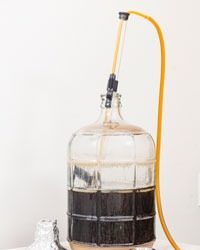Attenuation & Flocculation for Beginners
So you’ve finished the boil, cooled the wort, pitched your yeast and put your fermenter in a quiet place to let the yeast do what it does best — turn that wort of yours into miraculous, wonderful beer. Over the next week or two the yeast will consume the sugars in the wort to create alcohol and CO2, a process known as fermentation. Once fermentation concludes it is time to rack the beer, but how can you be sure your beer is fully attenuated?
Sure, the hardest part is over, but fermenting beer isn’t like cooking dinner in a rotisserie oven where you can just set it and forget it.
Measuring attenuation rates (the percentage of sugars yeast consume during fermentation) is an important step throughout fermentation that is done by tracking the specific gravity of a sample of the wort. The specific gravity of water is 1.000. The density of wort is higher primarily due to the sugars in it. As yeast consume the sugars the density — and therefore the specific gravity — drop. The percent of sugars the yeast consume is known as the apparent attenuation percentage. Alcohol must be removed to determine the actual attenuation percentage, however; homebrewers and even some commercial brewers often just rely on the apparent percent.
The first number you need in order to calculate the apparent attenuation percentage is the original gravity (OG), which is the specific gravity of the wort prior to pitching your yeast. After adding yeast, collect a sample of the wort that you can use to take daily hydrometer readings. Remember to record your data from each reading. The specific gravity should drop each day during active fermentation as the sugars are eaten. Fermentation is complete once the specific gravity remains constant three consecutive days. At this point, record the specific gravity, which is your final gravity (FG).
Use the following equation to calculate the apparent attenuation percentage:
[(OG-FG)/(OG-1)] x 100
Yeast strains come with stated attenuation ranges (typically between 65-85%). A handful of factors such as mashing temperatures, fermentation conditions and gravity of a particular beer may cause attenuation to vary, but when your beer is through fermenting it should fall within the range of the yeast used. Those ranges are useful when choosing yeast for a specific beer style. For instance, when brewing an American pale ale you want a yeast strain that will produce a dry finish and allow the hop flavors to come through. Chris White, president of White Labs, suggests in a BYO article from January 1999 that a good choice would be a neutral yeast with an attenuation of 70-80%. When making an English-style mild ale, White suggests a strain with a lower attenuation in the range of 65-70%.
Following fermentation, yeast normally flocculates (when cells aggregate together into clumps and descend to the floor of the fermenter) leaving a clean, clear beer above it. If yeast flocculate too early the beer will be under-attenuated and sweet, and may contain unacceptably high levels of diacetyl (butter-like aroma) and acetaldehyde (green apple aroma). In the case the yeast does not flocculate, the beer will remain cloudy and have a stronger taste of yeast.
Not all yeast flocculate at the same rate. Beer styles that are known for their cloudy haze, such as a hefeweizen, use yeast with a low flocculation rate (the cloudiness in commercial examples is also due to being unfiltered) while an English ale strain would fall on the other end of the spectrum.


